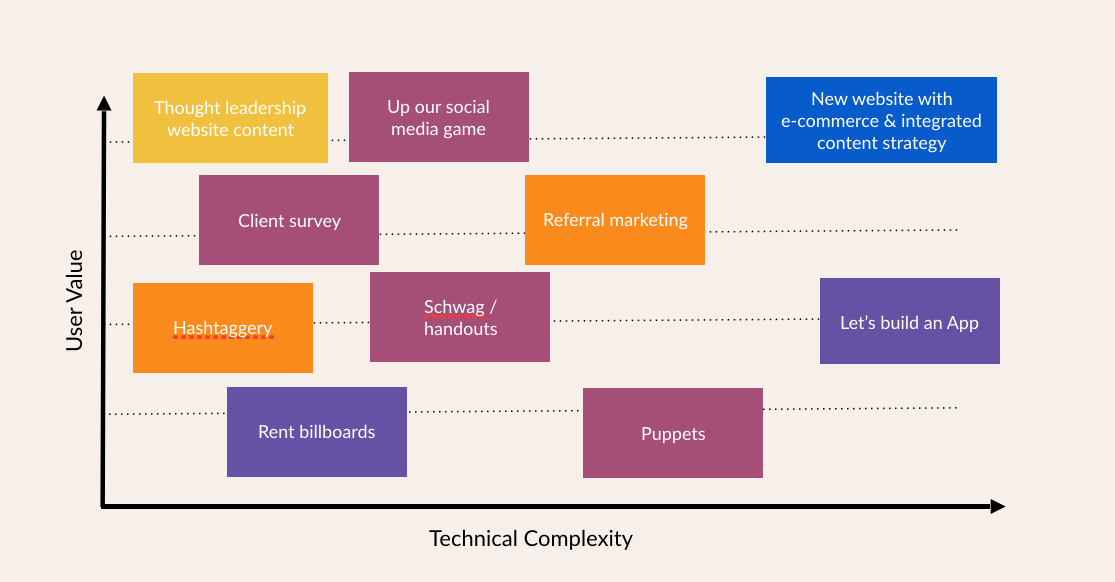Turning business problems into marketing priorities
As an innovative technology company, you’ve likely used a design sprint or something like it to bring new products and services to market. Creative agencies employ a similar method to brainstorm, scope and execute marketing initiatives.
What’s unique about the process, and how can it help you address your business challenges? It starts with uncovering and addressing the right problem from the right perspective, and it ends with a prioritized list of ways to address the problem.
Discuss, define and defend the problem
Before you task your creative agency or in-house team with executing a specific marketing deliverable, take a step back and make sure you’ve articulated a specific business problem.
If you haven’t first discussed, defined and defended the problem at hand, any solution will be half-baked at best.
Different team members likely have different solutions in mind. The CEO might want a new website. The product team might want new messaging. Sales might want a new product. Marketing might want to reach a new audience. The creative team might want puppets — creatives like to keep things lively. So how do you decide what your company actually needs?
Get all stakeholders in the same room
This process is inclusive and hands-on by nature — engaging your sales, marketing, product and creative teams, along with the ultimate decision-maker. Give the renegades, rebels and naysayers a seat at the table. Engage them early, and you’ll reduce your risk of being thrown a curveball later on.
Check your solutions at the door
This isn’t a meeting about your new website. This is a meeting to articulate the problem that led you to think you need a new website … or puppets. Question current assumptions and focus on defining tangible needs. The ultimate deliverable might still be a website, but if you haven’t first discussed, defined and defended the problem at hand, any solution will be half-baked at best.
Get specific and get to the core of the problem
Has a new competitor positioned itself as a more innovative option? Are you reaching a lot of people — just not the right people? Do customers think of your solution as their secret weapon and therefore don’t refer you to colleagues? Is your technology pigeonholed as one type of solution, when it’s capable of doing lots of things?
Be precise. “We need to sell more product” is not a specific business challenge. It’s a big problem — too big for a brand design sprint to solve. If a problem this large is your starting point, unpack it and get to the core.
If there is a problem,
Yo, I’ll solve it.
Check out the hook while my DJ revolves it.
— Vanilla Ice
Prioritize your big ideas
Now that you’ve reached a consensus on a clearly articulated business problem, you can uncover the human emotions behind that problem and start brainstorming ideas to address it.
Get human about client pain points
Every B2B technology purchase is made by a human seeking to soothe a particular emotional pain. How does your technology make your audience’s lives easier, give them more time with their families, make them feel more secure in their jobs? What do clients who love you love about your brand?
Document how you provide a human-centered solution to your potential clients’ particular pains. Dig deep and go beyond the distinguishing features of your solution — spell out the benefits to your clients and prospects. Map out how each benefit addresses a specific pain point.
More often than you’d think, the right solution is the child or grandchild of a really bad idea.
First, get divergent
At this stage of the process, there are no bad ideas. Prioritize quantity over quality. Throw everything up on the wall. Be flexible and iterative. How might you address your problem if there were no limitations? What’s the riskiest way you can face it? How might a five-year-old approach it? Don’t think about being clever or innovative. Get silly. Have fun.
Great ideas can come from anywhere. If you think something, say something. Don’t let the loudest voices and strongest personalities dominate the conversation. Prime the quiet person in the back of the room.
Draw connections between seemingly disparate ideas. Build on top of other ideas. More often than you’d think, the idea that leads to an effective marketing solution is the child or grandchild of a really dumb idea — one you were almost too embarrassed to articulate.
Next, get convergent
Take a break. Then come back and look at every idea the team generated. Start to group similar ideas and remove redundancies. Plot out ideas based on how technically complex they will be to execute and the potential value they create for customers and the marketing team.

Ideas generated during a recent brand design sprint — plotted out on axes of user value and technical complexity
Select your top three ideas and put them on the calendar
At this point, you should have no shortage of ideas. But ideas become much more potent once you focus and prioritize them. Don’t fight for your own ideas. Rather, objectively assess how each might address your business problem. Select three ideas at most (nope, you can’t have 12), and set dates for when you’d like to see each idea fleshed out to a solution and when those solutions will hit the market.
Now get to it
Marketing is a quantitative and qualitative science that rewards those who are agile and act quickly. Follow this process to understand customer pain points, develop big, brave ideas and empower your creative team to do their best work.
About Tom Campbell:
Tom is Toolbox’s co-founder and creative director. When he’s not keeping the ‘Box rocking, Tom can be found backstopping his beer league hockey team or playing drums for local bar bands. He’s also a founder and fairy godfather of Art Lab Fort Collins and keeper of TomLovesTheLibertyBell.com, a quirky repository of stories and stats on Liberty Bell replicas around the world.
About Toolbox Creative:
Toolbox Creative is a B2B Brand Engineering firm, helping mission-driven organizations assess their brand equity, clarify their positioning and amplify their voices — creating lasting impact and building brand love.



